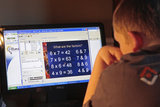 Here’s a pop quiz: since their inception in the 1990s, the Standards of Learning tests have (a) relied exclusively on multiple-choice questions, (b) rewarded rote memorization, (c) resulted in ever-higher passing rates, or (d) none of the above. Go to the head of the class if you correctly answered “none of the above.”
Here’s a pop quiz: since their inception in the 1990s, the Standards of Learning tests have (a) relied exclusively on multiple-choice questions, (b) rewarded rote memorization, (c) resulted in ever-higher passing rates, or (d) none of the above. Go to the head of the class if you correctly answered “none of the above.”
The Standards of Learning, or “SOLs,” establish the basic curriculum that public schools must cover, including minimum content standards in English, math, history, and science. How to implement the curriculum is left to local school systems. For two decades, students in grades three through eight have had to take SOL tests at the end of the year, and high school students at the end of certain courses to provide accountability to the public and to monitor progress in closing achievement gaps.
But with new times come new challenges. Virginia reviews the SOLs on a regular basis, with public notice and participation, to ensure that they cover the knowledge and skills that our students will need in the 21st century. As each SOL is updated, the Board approves a new SOL test in that subject. Results from the latest round of SOL tests reflect both the higher expectations we have for students and the progress they are making.
For example, new math SOL tests were administered a year ago, in the 2011-12 school year. The new tests require students to demonstrate their command of more challenging content as well as critical thinking and problem-solving skills. Administered online (as are all SOL tests today), the new math tests included not only multiple-choice questions but multistep problems, open-ended questions, and technology-enhanced tasks such as creating graphs and highlighting features on a diagram. In the first year of these more rigorous math tests, passing rates dropped across the state, sometimes dramatically.
Results from this year’s math SOL tests, however, show that students, teachers, and parents are responding to the challenge. In the 2012-13 school year, 71 percent of students in the state passed their math SOL tests, up from 68 percent last year. Students posted gains at all grade levels, and many local school systems achieved passing rates exceeding 80 percent in algebra, geometry, and other courses.
This year also marked the advent of challenging new SOL tests in English and science. The new tests reflect more rigorous content standards and more emphasis on critical thinking skills. Not surprisingly, as with the new math tests a year ago, passing rates in English and science declined this year at all grade levels. Statewide, passing rates in English ranged from 70 percent in grade 4 reading (down from 88 percent a year ago) to 89 percent for high school reading (down from 94 percent). Scores on the new science SOL tests ranged from 75 percent in grade 5 (down from 88 percent) to 86 percent in chemistry (down from 93 percent).
The initial dip in SOL scores does not mean that our students are learning less. It means that our schools are expecting more. In the global economy that awaits them, our graduates will need to have a deeper understanding of content, critical thinking skills, problem-solving ability, and an understanding of technology. In short, we are expecting more because colleges and employers are expecting more.
As schools adapt to the new SOLs and as our talented, hardworking teachers continue to engage students, I am confident that we will see improvement in English and science scores just as we did in math scores. In turn, we will improve the odds that our graduates are equipped to succeed in a competitive, fast-changing world. We owe it to our students and to ourselves to set high expectations—and then to do all that we can to help each student meet those expectations.

Email this author
- The Most Progressive Budget in Virginia’s History - December 21, 2019
- When is a Clean Water Act Permit Needed? - December 21, 2019
- Should U.S. Consider Modern Monetary Theory to Improve Economy? - December 21, 2019
